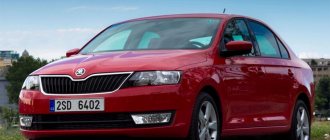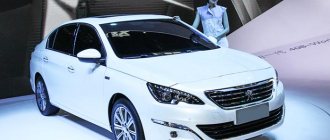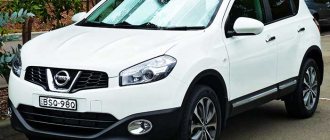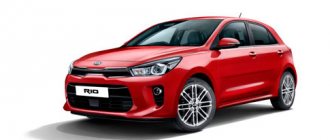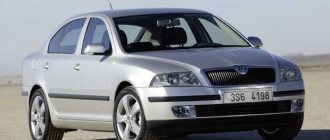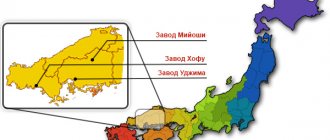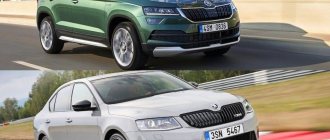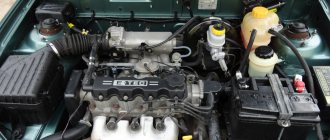The Czech subsidiary of the Volkswagen Corporation, represented by the separate rich and famous Skoda brand, in 2012 began another round of renewal and development, which continues to this day. Among the important updates was the appearance of the new Skoda Rapid model, which occupies an intermediate position between the small Fabia hatchback and the Octavia liftback, which has matured significantly in the last generation. The model turned out to be quite successful; it actually repeated the dimensions of the Octavia Tour, but became 9 centimeters longer.
Increasing the wheelbase and interior space clearly has a positive effect on car sales. The main ideological competitor of the Rapid in the Russian market is the Volkswagen Polo - actually the brother of this car. But the Skoda has a longer interior and a slightly larger luggage compartment. Also, the liftback body shape provides some benefits for the buyer. Today we will talk about some features, as well as places of assembly of the Czech new product.
Assembly and production - localization only in the CIS
The car is sold in many countries where the Skoda brand is historically represented, but the car is produced exclusively in its homeland, as well as in the CIS countries. The production of units and body parts takes place in the Czech Republic, at the company’s main plant in the city of Mlada Boleslav. This enterprise produces all the main units and components of the machine.
Then some of the spare parts remain at this plant and go to the assembly shop. Rapids are produced here for Europe, which, by the way, have also become in great demand among practical residents of the Old World. The next assembly point was the Ukrainian assembly shop in Solomonovo. Cars are manufactured here exclusively for the Ukrainian market. In Russia, the Volkswagen plant in Kaluga carries out the following work:
- welding the body from finished metal parts and performing metal processing and painting;
- full-scale vehicle assembly, performing all assembly processes on a specially dedicated line;
- testing of finished cars, conducting pre-sale preparation for the delivery of cars to Russian showrooms;
- conducting marketing activities, concluding contracts for direct deliveries of cars to enterprises;
- other commercial issues that are handled by a full-fledged Skoda representative office in Russia.
The plant in Kaluga produces Volkswagen Polo and Skoda Rapid exactly in the mode described above. The automaker's mandate could soon expand significantly to meet changing legislation and make cars even more accessible to buyers. The Russian market is a priority for Skoda, therefore there are many special programs and plans for it.
Another place where Skoda Rapid cars are assembled is a plant in Kazakhstan, in the city of Ust-Kamenogorsk. Here they produce a small series of cars for the domestic market in order to avoid huge duties on the import of finished cars. Such a flexible approach to business allowed the Skoda corporation to become one of the European leaders in car production.
Who collects and where
The main manufacturer of Skoda Karoq cars is a Czech plant located in the city of Mlada Boleslav. Its capacity allows it to produce at least two thousand cars every day, and we are talking not only about Karok crossovers, but also other popular models of the brand (Octavia, Fabia, Rapid).
Most of the company's processes are automated, so it can operate around the clock. People can only monitor the result, configure and maintain robotics, and deal with some minor production tasks.
Despite the enormous capacity, and the plant in Mladá Boleslav can assemble up to 700 thousand units annually, demand requires the concern to produce even more cars. To help the main production in the Czech Republic, another one was organized: in the city of Kvasiny. Most of its products remain in the country or go to showrooms in Europe.
It is important to note: The Škoda company is part of the Volkswagen group, so the equipment used in the factories meets the highest German requirements.
Technical features and individual features of Russian-assembled Rapid
Rapid is one of the flagships of the corporation, which is why quite serious attention is focused on it. It should be noted that most current buyers of pure C-Class cars consider this model as one of the best purchasing options. However, the Czechs still have ways to develop and improve the car.
The Russian assembly is somewhat different from other proposals. If in Ukraine and Kazakhstan they produce a completely identical European Rapid model, then in Russia they produce a car with individual technical characteristics. The features of the car in comparison with its European twins are as follows:
- the base 1.2 MPI engine is the smallest unit in the line with a potential of 75 horsepower;
- the iconic 1.6 MPI power unit with 105 horsepower has become the main one for the Russian Skoda Rapid;
- there is also a 1.4 TSI - a charged gasoline engine from the Germans with 122 horses in reserve;
- the junior engine comes only with mechanics; for the TSI, only a 7-speed DSG robot is available;
- The flagship 1.6-liter unit is equipped with both a manual transmission and a traditional automatic transmission.
The younger three-cylinder engine is known to Skoda car buyers from the old Fabia model. But in its current version, the engine has been significantly improved, negative features have been eliminated, and made more reliable. This particular model is one of the most popular today, thanks to its low fuel consumption (5 liters in the combined cycle), as well as good dynamic characteristics.
Experts consider the optimal purchase to be a car with a 1.6-liter power unit and a standard automatic transmission with high reliability. This tandem will be able to carry you with excellent comfort for hundreds of thousands of kilometers, providing only the positive features of traveling by car.
Russian-assembled Skoda Kodiaq: popular test drive from an experienced VAG driver
We have already written articles about the Kodiaq four times, so when Skoda invited Drom to Altai to test a Russian-assembled crossover, we had to seriously think: what new can be written about this car? They found an unusual solution to the problem: we need to change the fighter and send not a professional journalist, but a true VAG driver on reconnaissance, who will always find something interesting even in the most ordinary and boring car - the main thing is that there is a combination of TSI and DSG under the hood! Fortunately, such a person is among our friends.
Good afternoon, dear readers, my name is Andrey Astra, and as many already know from my posts on the Drom.ru forums and in the comments, I am a fan of VAG cars (here is my review about the Rapid 2015, and here about the Octavia 2010). In the winter of this year, I had the opportunity to drive the editorial VW Tiguan for four months, which is equipped with a CZPA 2.0 TSI engine with 180 hp, all-wheel drive and a DSG-7 DQ500 transmission.
Of course, it was interesting to compare the Skoda Kodiaq with it as a relative on the platform, but slightly lengthened and additionally equipped with driver assistants. So I immediately agreed to the offer to go for a test drive of this crossover! Moreover, Skoda decided to conduct tests in Altai, and I myself live in Novosibirsk - it’s not far away.
I arrived at the test drive location on my own in my personal Skoda Rapid. Average fuel consumption on a route of 445 km for the 1.4 TSI was 4.4 liters per 100 km
If there was a choice of engine/gearbox configurations from the cars provided for a test drive, I would choose the option with the CZDA 1.4 TSI 150 hp engine. and all-wheel drive - to understand whether this particular configuration has a chance for life and success, how much it is “enough” in most standard and not very standard road situations. By the way, this option is now gaining popularity among buyers. However, all test cars were equipped with a 2.0-liter CZPA engine and all-wheel drive in an almost top-end configuration, which means that you will have to compare a similar configuration with the Tiguan, the bonus of which is auxiliary driver assistants, which in the editorial Tiguan, with the exception of the distance control system, No. The only difference, perhaps, is in the tires: a couple of cars were on 19-inch Triglav wheels, the rest, including our example, were shod on 18-inch Triton wheels with Yokohama BluEarth-A AE50 tires measuring 235/55 R18.
How does a Russian bear differ from a Czech one? (Recall that the Czech crossover is named after the Kodiak bears living in Alaska). Last year there was a fairly detailed review of the first copies of the “Czech”. The Russian assembly introduced some minor adjustments. Firstly, the doors have lost the edge protection mechanism in most trim levels. Secondly, the combined seat upholstery (leather/faux leather/Alcantara) is not available to order. And thirdly, a budget base version has appeared with a CZCA 1.4TSI 125 hp engine. on a manual transmission with front-wheel drive. Otherwise, there are no differences in quality or equipment.
I don’t see any point in describing the details of the exterior and interior again; there are already many reviews and videos about this; I decided to concentrate specifically on the driving process and on the sensations as a passenger, in order to look at the car from this point of view.
Alas, all Kodiaks on the test were the same. The difference between crossovers is only in body color, wheels and tires
The first day of the test drive was more of an introductory one; after the morning briefing, we received the cars and were divided into crews of two people per car. With me in the crew was a rally master of sports, an automobile journalist, and a coach and teacher of emergency driving, Egor Vasiliev.
From left to right: me, Egor Vasiliev
Vasiliev turned out to be an excellent partner, I was glad to spend a couple of days with him and learn a lot of new things. In the photo above, Egor photographs Altai chicks 
We made ourselves comfortable in the car and drove off. Day one is a short trip from the Altai Resort hotel, near the village of Urlu-Aspak, to Manzherok.
The day is more of an introductory one than a test drive, especially for me, who is accustomed to looking at this car from the “other side”, solving some problems that arise with it (my main job is servicing and repairing Skoda cars). Today I’ll just be in the shoes of a consumer, albeit a potential one. We slowly move in the flow, I periodically glance at certain interior design solutions, finger and stroke the interior elements, look into various niches and glove compartments.
The ergonomics of the cabin, in my opinion, are thought out and strict; for me personally, everything is in its place. The interior differs from the usual only in small details of the location of the glove compartments and some functional buttons. For example, here in the area of the gearshift handle the main drive control buttons are concentrated, while at the same time the comfort control is concentrated in the central part of the console under the multimedia system display. The electrically adjustable driver's seat allows you to sit in any comfortable position, and there is also lumbar support.
In general, the driver’s seating position is practically no different from the Tiguan’s, and the front passenger has the same amount of space. But in the second row behind the Kodiak there is a clear advantage: it feels like “well, there’s a lot of space and not much else”, taking into account the fact that the trunk will fit not only a folded stroller with a small suitcase, but quite voluminous luggage (of course, in the case of a five-seater execution).
Our configuration includes three-zone climate control, so after a walk in the rain, we, being pretty wet, were able to not only quickly warm up, but everyone in their zone determined the temperature that was comfortable for them; at that moment, I personally chose the Hi mode!
The second day of the test drive was the main one. The route was planned in such a way that we would drive not only on asphalt, but also along country gravel paths; if desired, we could move away from the route and “feel” the car on various near-mountain climbs. The farthest point was a pass located near the village of Yabogan, and the road to it went through Cherga and the village of Verkh-Kukuya, the return route ran along the highway through the village of Yelo and further through the Seminsky pass along the Chuysky tract.
What exactly interested me in this test drive? First of all, understand how different the handling is from a similar Tiguan configuration and how the driver assistant systems work, namely:
• adaptive cruise control with Stop&Go function, • blind spot monitoring system, • lane keeping assistant.
The remaining systems, in general, have already been tested and well described. For example, distance control and Drive Mode Select (drive mode selection system). By the way, ahead of the questions in the comments: you will not find in the Kodiaq price list any indication of what kind of system there is with adaptive cruise control and the Stop&Go function. It should be clarified that there are two options: adaptive cruise control operating up to 160 km/h (code PLI), and adaptive cruise control up to 210 km/h - code PLJ. Both options have the Stop&Go function, which allows you to maintain a distance from the car in front until it comes to a complete stop, and then independently resume movement when the car starts moving. If it stands longer than a certain time (according to my measurements, more than three seconds), the system will issue a warning “ACC is ready to start,” but will not resume movement until you press the gas. Thus, the system does not replace the driver’s actions, but only helps him in some situations, for example, in “taffy” situations with limits of 40-60 km/h and speed bumps. In any case, the driver controls the car, and you need to be careful. We managed to shoot a short video of this system in operation, which is published at the end of the text. Also in the video you can see the work of the lane assistant and the passage of the diagonal.
Driving this seemingly large “bear” you don’t feel the weight of the car at all. When you look in the rearview mirror and see a “tunnel” to the rear window, where you can accommodate a third row if desired, you mentally prepare to “work” behind the wheel, but in reality this feeling does not arise, the “bear” obediently and easily obeys the steering wheel, clearly describing the trajectory that you are laying. Coming out of a turn does not bring any surprises; the Kodiak emerges from it with minimal roll, at least with an average load. During the time I spent behind the wheel, I was never able to distinguish its behavior from the behavior of a passenger car. In most situations, if you need to accelerate, the torque of the engine is enough. After all, this is not a sports car, and even nowadays, special speed qualities are not required from a car, since the traffic density is high, and you want to spend the time spent on the road in comfort - so that the fatigue from driving is minimal. However, even if it is necessary to drive the car intensively or even aggressively, the Kodiak will quite meet you halfway and give you minutes of drive, especially if the wheels are not on asphalt, but on snowy or rough terrain. The exchange rate stability systems allow a little more freedom of action compared to the Tiguan, and if desired, you can arrange a start with Launch control, the so-called “two-pedal” start. Until now, did you know that the stock “vegetable” Kodiak has such a function? If anyone is interested in how to reach her, write in the comments, I won’t write specifically here, let it remain an intrigue.
In winter, I tested the Tiguan on an ice track, and there the difference between the normal ESC mode and the ESC-Sport mode is more significant than on the Skoda, in my opinion. Thanks to a crew mate with a sports background, we were able to test the Kodiak a little in corners and compare the performance of the settings. Before entering a turn, we select the speed in such a way as to achieve drift of the car at a small radius, then the resulting understeer is compensated by the exchange rate stability system, “correcting” the trajectory by braking the wheels and steering (the steering wheel is electric, and it actually rotates, literally breaking out of your hands, but not so much that a person would not overpower him). At the exit of the turn, we actually load the wheels with maximum traction torque on the straight line, and the car simply flies out of the turn, throwing dust and stones behind it. We repeat such experiments many times. We did not find any significant difference between ESC modes. Perhaps only in the ESC-Sport mode the steering is weaker, which seems to hint to you - take the steering wheel and drive it yourself. In general, the character of the car is front-wheel drive with a tendency to understeer. This is felt in moments when the car is not yet “ready” for fast maneuvers, when it drives imposingly and at ease, and suddenly the “slalom” begins. This is where electronic systems come in and torque distribution, understeer compensation, steering and other actions begin, and the key here is electronic systems. Let's imagine for a moment that all these functions in the ESC block have disappeared somewhere. The carriage turns into a virtually uncontrollable pumpkin (the electric rack is so tuned that if feedback is lost, the car cannot be recognized) and only skill, experience and skill can pull the car out of a “steep dive”, and only if there is room for maneuver. This is about how important it is to keep your car in good condition.
The lane keeping assistant deserves special attention. You'd think it would take over control most of the time on marked roads, but that's far from the case. Because this is only an assistant, and not a “substitute” for the driver’s actions. When testing it, I discovered many nuances, one of them: even with ideal markings, the car will move as close as possible to the right marking line (solid or broken), that is, closer to the right edge of the lane. If the road is narrow and the markings are literally on the edge of the roadway, then there is a high risk of hitting cars standing on the side of the road or other obstacles, especially if the section of the road goes to the left. If the road is two-lane, and the markings are only one line in the center, then the system practically does not work.
The assistant starts working at speeds above 65 km/h. If the speed drops below this value (for example, you are driving in traffic with adaptive cruise control and are not really thinking about what is ahead), then at a certain point you need to take control. Also, the assistant will not be able to help when going around a hole or, for example, a large animal standing on the road, or if there is a fairly sharp turn ahead and the speed is too high for maneuver. By the way, for comparison, I also tested another car with such an assistant, because I thought that perhaps the camera was not calibrated correctly and the car was pulling to the right. But the second Kodiaq also tried to stick to the right edge of the lane, which, to be honest, is not very convenient and sometimes dangerous.
At the moment I think this assistant is damp. It would be more useful to have a function for detecting speed limit signs and adjusting the cruise control speed accordingly. Such systems already exist, but our Kodiak does not have it.
Blind Spot Assist is perhaps the simplest and most common system. It alerts you to the presence of another vehicle in an area not visible in the rear view mirrors. Illuminated pictograms are built into the mirrors, and radar sensors are located inside the bumper cavity. There is no particular need to test this system, it works simply: when a car approaches from behind in the adjacent lane, an orange pictogram lights up on the corresponding side, warning the driver that he needs to be more careful.
Of much greater interest to me was the measurement of the so-called “gasoline noise”: what will the knock sensor show us for the 95-octane gasoline poured into the test cars? (We received the data through special diagnostic equipment - ODIS). At peak load it showed values four times higher than the figures I got on the Tiguan in winter. In light load and idle modes, the values were approximately the same. Does the temperature difference (-15°C versus +20°C) really have such a significant impact? But it was not so much this that surprised me as the boost pressure. Structurally, the same engine with the same letter designation CZPA on the Tiguan gives a boost pressure of 1.7 bar (1 bar atmosphere + 0.7 bar boost), while on the Kodiak it calmly stays at around 2 bar (1 atmosphere + 1 supercharging), while the declared power is the same 180 hp. and torque 320 Nm. Unfortunately, I haven’t yet had time to physically examine the turbine itself in Volkswagen and Skoda and understand whether there are any differences, but now I’ll definitely do it.
Selfie with TSI in the background - happiness for a true VAG driver!
Some time later, upon arriving home in Novosibirsk, I was able to agree to test a Kodiak with a 1.4 TSI engine and all-wheel drive to compare the dynamics. I was pleasantly surprised that the engine is sufficient for most standard tasks, and acceleration from 0 to 100 km/h is not inferior to the average passenger car, namely in the region of 10 seconds. Although these “races” are of no use to SUV class cars. I definitely like the Kodiak, it’s quite possible to think about purchasing it in the future and with the 1.4 engine. This is a more budget-friendly and sufficient option for me personally. For now these are dreams, but as we know, they come true.
In conclusion, I would like to note that this test drive was also attended by representatives of the brand from the Czech Republic, in particular, the head of the Skoda brand in Russia, Jan Procházka. There was an opportunity to ask questions. I was more interested in the prospects for the appearance of cars equipped with the new 1.5 TSI engine: should we start to be afraid of it now or will we still live with the good old 1.4 TSI EA211? The answer is we’ll wait for now, since we don’t have Euro-6 gasoline yet.
Jan Prochazka
There is no answer yet to the question about the possibility of retrofitting cars that were not originally purchased in top trim levels. Often the owner has a desire to install (or unlock) certain factory options. Why and for how long are Russian-made cars deprived of this opportunity? I’m not talking about retrofitting cars with cruise control, including adaptive, but even basic activation of voice control or a fatigue recognition assistant is now impossible! SWAP (SoftWare As Product - that is, software activation of functions blocked at the factory) does not apply to us! It’s good that the problem of the Smartlink system (which includes Android Auto and Apple CarPlay) was solved: recently, the activation key for this system can be purchased and activated through dealerships.
This is where I will finish the story, below there will be a short video, shot on a simple mobile phone, edited and cut on my own and almost for the first time, you can criticize it.
See you in the comments, Andrey Astrakhantsev was with you.
Have a good ride!
Technical specifications Skoda Kodiaq 2.0 TSI DSG Style Plus (manufacturer data)
| Body | ||
| Type | Station wagon (SUV) | |
| Number of seats/doors | 5/5 | |
| Engine | ||
| Type | Petrol, with combined injection and turbocharging | |
| Engine location | Front, transverse | |
| Number and arrangement of cylinders | 4, in a row | |
| Working volume, cubic meters cm | 1984 | |
| Power, hp at rpm | 180/6000 | |
| Torque, Nm at rpm | 320/3950 | |
| Transmission | ||
| Drive unit | Full | |
| Transmission | 7-Manual transmission (DSG) | |
| Brakes | ||
| Front | Ventilated disc | |
| Rear | Disk | |
| Suspension | ||
| Front | Independent, spring, McPherson | |
| Rear | Independent, spring, multi-link | |
| Dimensions, volume, weight | ||
| Length/width/height, mm | 4697/1882/1676 | |
| Wheelbase, mm | 2791 | |
| Ground clearance, mm | 187 | |
| Curb/gross weight, kg | 1738/2453 | |
| Fuel tank volume, l | 60 | |
| Trunk volume, l | 635–1980 | |
| Tires | 235/55 R18 | |
| Dynamic characteristics | ||
| Maximum speed, km/h | 205 | |
| Acceleration to 100 km/h, sec. | 8,2 | |
| Fuel consumption, l/100 km | ||
| Combined cycle | 7,4 | |
| CO2 emissions, g/km, eq. Class | N.D., Euro-5 | |
| Cost of the car, rub. | ||
| Basic for 2.0 TSI DSG Style Plus | 2 689 000 | |
Photobonus
Video bonus
The future of Skoda Rapid in Russia and its main competitors
The car's competitive lineup is significant. This includes the Korean compact sedan Hyundai Solaris, as well as its sibling based on the Kia Rio, and the German Volkswagen Polo Sedan, and even the budget Renault Logan, which has been ranked first in sales in Russia for several years now. You can also count the new Priora from VAZ as a competitor to Rapid, which it promises to make unrecognizable, modern and technically advanced.
But all rivals are left behind if we consider the true list of positive qualities of the Czech car. Among these characteristics, we can highlight the following important features for any car enthusiast:
- Czech origin of each unit - high European quality and multi-level control;
- beautiful modern design of the car, striking similarities with the more expensive and executive Octavia;
- impressive interior dimensions, a huge amount of free space for passengers and driver;
- excellent layout of the interior, a successful liftback solution - opening the trunk lid along with the rear window;
- reliable technology, which takes its roots in expensive German developments of the legendary Volkswagen concern;
- optimal pricing and loyal attitude towards the Russian buyer on the part of the company.
If the cost of Korean cars grows in proportion to the jump in the exchange rate of foreign currencies in Russia, then the Czechs are in no hurry to significantly increase the cost of cars. Even the most popular in the class, Logan, hastened to multiply the price tag by the inflation rate, which made it a direct price competitor to the Skoda Rapid.
Today, in Russian showrooms, the most affordable Rapid can be purchased for a very modest 539 thousand rubles. But the version with the 1.6-liter engine and automatic transmission has the greatest sales potential, costing 637 thousand. This additional payment of 100 thousand rubles is clearly worth purchasing a car with such an interesting technical part.
We invite you to watch an interesting film about car assembly at a plant in Kaluga:
Let's sum it up
A beautiful and modern Czech car has become one of the most attractive offers in its class. The company's pricing policy, active monitoring of the quality of production and assembly of the machine, as well as the desire to become even better make Rapid a true segment leader. The popularity of the car is growing rapidly, and reviews from real customers inspire even more confidence in this new model.
Skoda successfully demonstrates that the current car market, saturated with offers, is ready for new products. New cars can still become iconic and popular without getting lost among the huge mass of competitors. Skoda Rapid is showing excellent growth rates, but how do you personally feel about the car?

